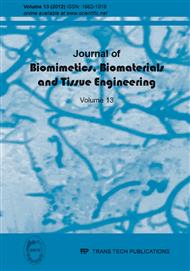[1]
M. M Rahman, A. G Olabi, M.S. J Hashmi, Finite Element Modelling of Rheological Property of Curing PMMA Bone Cement. Part 1 Effect of Prosthesis Insertion Velocity, J. Biomimet. Biomat. Tiss. Eng., 2012; 12: 83-90.
DOI: 10.4028/www.scientific.net/jbbte.12.83
Google Scholar
[2]
W. R Krause, J. Miller, P. Ng, The viscosity of acrylic bone cements, Journal of Biomedical Materials Research, Vol. 16 (1982), 219-243.
DOI: 10.1002/jbm.820160305
Google Scholar
[3]
D. F Farrar, J. Rose, Rheological properties of PMMA bone cements during curing, Biomaterials, Vol. 22 (2001), 3005-3013.
DOI: 10.1016/s0142-9612(01)00047-3
Google Scholar
[4]
N. J Dunne, J. F Orr, Development of a computer model to predict pressure generation around hip replacement stems, Proceedings Of The Institution Of Mechanical Engineers. Part H, Journal of Engineering in Medicine, Vol. 214, Issue 6 (2000).
DOI: 10.1243/0954411001535679
Google Scholar
[5]
N. J Dunne, J. F Orr, Influence of mixing techniques on the physical properties of acrylic bone cement,. Biomaterials, Vol. 22, Issue 13 (2001), 1819-1826.
DOI: 10.1016/s0142-9612(00)00363-x
Google Scholar
[6]
Y. P Arramon, E. A Nauman, The Intrinsic permeability of Cancellous Bone" from "Bone Mechanics Hand Book, (2nd Edition)- Edited by Stephen C. Cowin, (2001).
Google Scholar
[7]
T. M Keaveny, Cancellous bone . Handbook of Biomaterial properties. Edited by J. Black and G. Hastings. Chapman & Hall, First Edition, (1998).
Google Scholar
[8]
N. J Dunne, J. F Orr, D. J Heylings, Measurement of Intermedullary Cement Pressure,. Innovation and Technology in Biology and Medicine, Vol. 19(5) (1998), 347-359.
Google Scholar
[9]
J. D Bryant, T. David, P. H Gaskell, S. King, G. Lond, Rheology of bovine bone marrow, Proc Inst Mech Eng, [H] Vol. 203, Issue 2 (1989), 71-75.
DOI: 10.1243/pime_proc_1989_203_013_01
Google Scholar
[10]
F. Canabal, B. Katz, A computational fluid dynamics simulation of PMMA cement flow upon insertion of a femoral stem into a bone cavity during a total hip prosthesis procedure, Advances in Bioengineering, Vol. 28, ASME, (1994), 165-166.
Google Scholar
[11]
Y. P Arramon, E. A Nauman, The Intrinsic permeability of Cancellous Bone" from "Bone Mechanics Hand Book, (2nd Edition) - Edited by S. C Cowin, (2001).
Google Scholar
[12]
M.M. Rahman Finite Element Modelling of Rheological and Penetration Characteristics of Curing PMMA Bone Cement in Total Hip Replacement, PhD thesis, Dublin City University, Dublin, (2006).
Google Scholar


